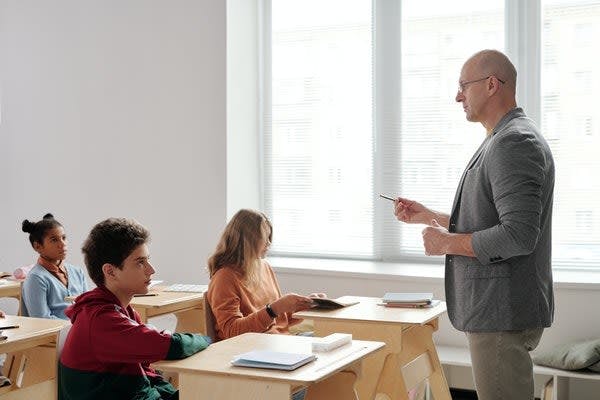Teaching methods

Education consistently remains one of the hottest topics in today’s world. Whether talking business, social equity, sustainable development or product design, education is considered paramount for thriving societies, successful business and cutting-edge industries. The United Nations listed equal education for all on the fourth place on their Sustainable Development Goals for 2030. Learning and Development departments are crucial for keeping up with the ever-changing markets and new developments. In what ways is knowledge being passed on? In today’s article, we would like to present a few contemporary teaching methods and how they’re being put into good use.
History of teaching methods
The history of education can probably be traced back to the most ancient times of humankind. Already in the Mesopotamian era, around 2000 BC, the Sumerians of the Middle East created schools to pass on the knowledge of the first alphabet from generation to generation. In China, only the children of the nobility were allowed to attend governmental schools created in towns, whereas the children of everyman had to obtain basic education in private schools opened in rural areas. In ancient India, education was considered extremely important and was imparted mainly through two religious’ systems: Vedic and Buddhist. Apart from oral and written skills, children were taught ritualistic and metric knowledge, as well as basics of medicinal skills. If we come back to the European continent, we see that the Greeks and Romans also paid much attention to pass on existing knowledge to further generations. One of the ancient teaching methods, the Socratic method of teaching, is still being used in today’s teaching. Learning and education were considered important for the development of a person’s mind, body and character. With carefully designed teaching methods, the learning processes, natural to the humankind, were to be improved and enhanced, boosting the development of an individual and in consequence – the entire society.
Teaching method categories
Teaching methods can be divided into various categories, depending among others on the learning environment, age group, learning goals, skills required, tools or subject matter. In this article, we would like to focus on methods falling into the spectrum between student and teacher-directed methods. In other words, whether the teacher or a student, wields the decisive power to craft the learning experience. There’s no better or worse choice here: both approaches have benefits and downsides and the successful application of either depends on the teaching goals, the environment and the student group itself.
Teacher-oriented methods
Among the teacher-oriented methods, so-called instructional methods of teaching or lecture-type technique count among the most popular and most effective teaching method. Here the teacher/coach demonstrates an approach to an issue and presents possible solutions to a problem[1]. Such an approach yields good results when a lot of knowledge needs to be compressed in an allocated period. It also helps with the pre-selection of learning material, adapting analytical approach and organizing extensive readings. Closer to the middle of the spectrum one can find such methods as worked examples or an EDGE teaching method (Explain, Demonstrate, Guide, Enable – particularly popular among scout groups). Another example is an interactive lecture, where students are presented with certain notions and solutions and immediately have to apply them to the problems. In the middle, we have Socratic questioning: a method already mentioned before. Here the teacher incites a discussion through carefully designed questions and students are tasked to find a solution to the problems given in the questions.

Below are the teacher-oriented methods that take on a more traditional approach to teaching.
- Direct Instruction – This is a method that relies on the teacher/instructor teaching topics through lectures and demonstrations. Learners understand information by listening attentively.
- Kinesthetic Learning – In this method, instructors create tasks or activities that will allow students to have a better understanding of the learning materials. Learners absorb information by doing activities or creating things or projects.
- Flipped Classrooms – This method teaches learners through pre-recorded instructional videos. Similar to direct instruction, learners gain knowledge by watching and actively listening to the recorded lectures.
Subject-oriented teaching methods
On the opposite side of the subject-oriented spectrum of teaching methods, are the student-oriented techniques, which could also be called constructivist methods of teaching. Here students are actively involved in construing, building and expanding their knowledge. Modern educational psychology theories claim that such methods count among the most effective teaching methods in accelerating the learning performance among small children, as they support the natural-occurring interests and talents in children and elders. Boosting natural predispositions with carefully tailored teaching plans and tools is said to improve the development of independent thinking, problem-solving and other skills in a non-coercive, stress-free environment.

Montessori method of teaching is one of the most well-known such methods. Montessori is a method of education that is based on self-directed activity, hands-on learning and collaborative play[2]. Montessori method of teaching organize the classrooms to be safe, well-designed and creatively decorated spaces, where children are encouraged to follow their interests under the teacher’s guidance. Studies show that experiential learning (“learning by doing”) leads to a deeper understanding of a given subject, be it Math, Biology, Music or Languages.
In the Waldorf teaching method, created by Rudolf Steiner in 1920s, great emphasis is put on the holistic dimension of education – it should “engage hand, head and heart”[3]. Hence arts as a mode of play and education have a big role in Waldorf schools. Creating interdependencies among the members of the group help to establish good communication and team-working skills. Jigsaw method of teaching, in which students cannot solve the problem without collaborating, is a good example of such a technique.
Below are the student-oriented methods where learners play an active role in their learning experience while the instructors facilitate the learning.
- Inquiry-based Learning – This method encourages students to be proactive in their learning by asking questions and conducting their own research. The instructor instead serves as a coach/support.
- Personalized Learning – In this method, learners have more control of what they want to learn and how they want to learn based on their own interests and skills.
- Differentiated Learning – Somewhat similar to personalized learning, this method allows instructors to tailor their tasks or activities based on the individual needs of the learners. Instructors can differentiate how and where a learner can access learning material, and how the learning environment is developed.
- Expeditionary Learning – This is a method of learning that takes place outside the classroom to gain real-world learning experience. Instructors can even leverage technology such as software to simulate these expeditions when real-life- or outdoor learning isn’t possible.
- Game-based Learning – This method focuses on developing soft skills among learners to encourage more participation and improve understanding of topics. It incorporates game concepts into the learning environment to develop mastery in an engaging way.
Contemporary teaching methods
But contemporary teaching methods are not only used in schools. After all, in our professional life, we also need to learn all the time. Pedagogical collaboration with adults demands a slightly different approach, fit for the topics, environments, goals and time frame, in which new knowledge has to be presented and absorbed. More freedom and independence is a must – most adult students have already mastered several learning techniques and procedures. Rather than a teacher or a guide, they need a comprehensive system organizing the information they are looking for. Not every training has to take place in person – and in times of pandemic, not every can! Here blended learning, that is a combination of in-person and online types of teaching methods comes into play, heavily supported by modern technology. Using online programs and apps is convenient, time-efficient and fun. Educational psychology theories prove, that diversification of stimuli and learning techniques improves the understanding, shortens the learning period and helps to retain information for longer.

In EdApp, a leading microlearning LMS solutions for business, cutting-edge technological solutions stand on a solid scientific foundation. Learning techniques that seem like fun – games, quizzes, puzzles, quick and easy manual tasks – are designed following the educational theories. Gamification theory is one of them. Turning dry, bland, uninteresting piece of information into a graph and a set of questions that end with a quiz, supported by beautiful visuals and voice records, turns an irritating chore into a dynamic and fun task that won’t last longer than 10 minutes. Microlearning is all about portioning knowledge into bite-sized chunks. Nothing too hard to swallow and you will be reminded to repeat that new guidance lines a couple of times, just to be sure you’ve remembered them. EdApp delivers top-notch courses right to your mobile device so you can start learning anywhere – on the subway or while walking your dog or chilling on a beach. Your choice.
Learning is a life-long experience both in formal and informal aspect. Our brains seem to have an endless capacity of remembering new words, linking pieces of information and gaining new skills through practising muscle memory. In today’s world learning doesn’t have to be tedious and boring. Contemporary types of teaching methods turn to learn into a game, but one with a solid psychological background. Here, even if you lose – you win.
To help you determine which modern teaching process best fits your needs, here’s a list of 10 contemporary teaching methods that you can try:
- Self-learning – Through this type of learning, individuals take the initiative to learn topics on their own without the guidance of teachers or trainers.
- Personalized Learning – Unlike traditional learning methods where learners are grouped together and are given the same learning materials, this contemporary teaching method focuses on customizing lessons based on each learner’s strengths and interests.
- Microlearning – With microlearning, you can provide your learners with bite-sized learning content that they can learn at their own pace. It also allows them to focus on each topic without getting overwhelmed with new information.
- Collaborative Learning – This usually involves a group of learners coming together to discuss topics, solve problems, or complete a task. In an online setting, this can be done through virtual classrooms, discussion boards, or breakout rooms.
- Gamification – Gamification allows you to incorporate game design elements and principles like rewards and leaderboards into non-game contexts like school learning or workplace training, making them more fun and engaging for learners.
- Spaced Learning – Through spaced learning, lessons are repeated in increasing intervals to improve long-term recall among learners.
- Project-based Learning – This is a method of learning that allows learners to gain new skills and knowledge by researching or responding to a problem or challenge.
- Experiential Learning – With this method, you can allow your learners to gain knowledge and skills by immersing themselves in hands-on activities like laboratory experiments, fields exercises, internships, and apprenticeships.
- Virtual Reality (VR) Learning – Through advanced VR technology, your learners can immerse themselves in a variety of situations or destinations without having to leave their classrooms, offices, or homes.
- Competency-based Learning – This modern teaching approach is based on pre-determined proficiency levels that learners are expected to reach as they progress through their education or training.
[1] https://fctl.ucf.edu/teaching-resources/teaching-strategies/teaching-methods-overview/
[2] https://montessori-nw.org/about-montessori-education[2] https://montessori-nw.org/about-montessori-education
https://fctl.ucf.edu/teaching-resources/teaching-strategies/teaching-methods-overview/
[2] https://montessori-nw.org/about-montessori-education
[2] https://montessori-nw.org/about-montessori-education
https://montessori-nw.org/about-montessori-education
[3] https://www.waldorfeducation.org/waldorf-education
Author
Guest Author Marta Rudnicka
Marta Rudnicka is a creative content writer with vast experience in writing, editing, translation, and data analysis. Aside from writing, their interests are centered on mental health, human rights, travel, and environmental concerns.
